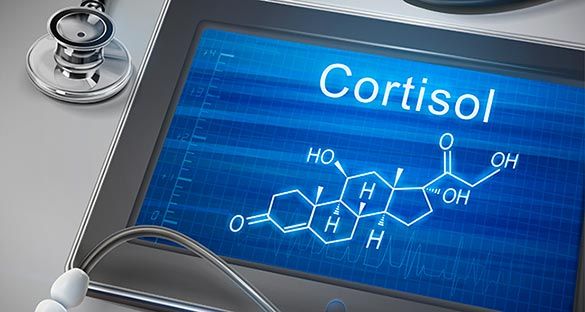
Cortisol, whether you’ve read about it in the news media or learned about it in health classes, is often maligned as the bad stress hormone. Have you ever wondered why there would be such a potent chemical in the body that only does harm? While too much cortisol in the body can certainly have a negative effect, cortisol plays several important roles in the body that are worth knowing about. Read on to learn about the good and the bad (and yes, the ugly) effects of cortisol.
The Good
Cortisol is produced in the adrenal glands, which reside at the top of the kidneys, and its release is stimulated by the hypothalamus. The daily release of cortisol follows a circadian pattern that is highest before waking and lowest at bedtime. Under normal conditions, the adrenal glands secrete between 20 and 40 milligrams of cortisol each day.
Cortisol plays numerous important roles, including control of substrate metabolism, immune response, wound healing, electrolyte and fluid balance, and more. Arguably, the least-known functions of cortisol are related to its impact on memory and its role in mood and feelings of satisfaction.
Cortisol moves freely into the brain, including directly into dopamine neurons. The dose of cortisol that produces beneficial effects on memory and elevated mood appears to be the daily amount secreted by the adrenal glands under normal conditions. Any stressor, especially a physical one, results in the release of cortisol. Physical and mental challenges evoke some level of discomfort, and ultimately result in the stimulation of cortisol release. Whether running a race or performing a symphony, cortisol is one component of getting out of the blocks or playing the first notes.
Cortisol is also released during high-intensity exercise to increase the production of glucose by the liver as well as free fatty acids into the bloodstream for energy production. In the brain, the release of cortisol combined with the euphoric nature of dopamine-releasing neurons may act synergistically to achieve a “runner’s high,” a state of “flow” and a sense of true satisfaction. According to Dr. Gregory Berns, a neuroscientist and psychiatrist: “Cortisol comes from stress, especially physical stress, and dopamine from novelty. Put the two together, and it is easy to see that novel physical challenges might be the best way to get the feeling of satisfaction we all crave” (Berns, 2005).
Dr. Berns goes on to describe why “a job well done” feels so good. The same combination of cortisol and dopamine, released and combined in the brain during physical exertion, helps us find a true sense of satisfaction from digging a ditch. Further research tells us that this is likely the same synergistic pathway that elicits a greater sense of reward and satisfaction from doing volunteer work for a cause, rather than just making a financial contribution (Ryff et al., 2004).
The Bad
Just a little too much cortisol and your experience will shift from enhancement of mood, heightened concentration and improved memory to impaired concentration, overstimulation and anxiety. Cortisol is a catabolic steroid, so too much, too often will result in degenerative effects on the body. An excessive increase in cortisol levels that is maintained over time will switch from fueling the body for high-intensity exercise to a possible correlation with an increased risk of obesity.
Ideally, the body should exist in an optimal hormonal environment to support health. Switching into a stress response and releasing the hormones associated with stress was an adaptation to a dangerous environment—the well-known fight-or-flight response. In a life-or-death situation, we have the capacity to very rapidly fuel the body, think clearly, raise mental energy and flee. Quieting the stress response requires a period of recovery, with a lack of significant stress. Simple things like laughing or listening to music can reduce cortisol levels. Without recovery, the system has no “off” button. That’s where things get ugly.
The Ugly
It’s ironic that the very system that is designed to save us can lead to illness, poor quality of life and even a shortened lifespan. As mentioned above, intense exercise can transiently raise cortisol levels, allowing for a sense of enjoyment and satisfaction. After exercise and recovery, cortisol levels return to normal. Recovery is essential for cortisol to return to normal. The fast-paced, yet sedentary lifestyles of many people can lead to ongoing stress, where recovery never happens and cortisol levels stay chronically elevated. In this scenario, blood sugar levels are not elevated momentarily for fight or flight; rather, they are consistently elevated. Too much cortisol also induces insulin resistance, which over time overworks the pancreas until its function begins to struggle and increases the risk of type 2 diabetes (Aronson, 2009).
Furthermore, the constant release of intramuscular triglycerides into the bloodstream from elevated cortisol may lead to weight gain and obesity. Fatty acids are relocated to visceral fat, especially in the abdominal area. The proliferation of fat cells, combined with insulin resistance, alters appetite regulation: hunger rises and satiation diminishes.
From this initial onslaught ensues a long list of compromised health factors that only serve to increase the stress on the body, and further up-regulate cortisol production:
- Increased systemic inflammation
- Decreased immune function
- Gastrointestinal problems
- Sleep disturbance
- Cardiovascular disease
- Fertility disorders
The only treatment course that will effectively short circuit the stress response is to institute evidence-based stress-management practices:
- Behavioral counseling
- Smoking cessation
- Regulate sleep
- Regular exercise
- Deep breathing and meditation
- Anti-inflammatory diet
- Minimize caffeine and alcohol
Overtraining syndrome is also related to cortisol. Physically challenging the body is a positive way to help the body to repair, adapt and grow stronger, faster and more powerful. Overtraining, however, is the result of training without recovery. Overtraining syndrome is not typically caused solely by high training demand. Rather, it is usually a combined effect with underfueling and possibly low carbohydrate intake, along with poor stress management and insufficient sleep and recovery. The high demand on the adrenal glands initially elevates cortisol levels, but ultimately leads to adrenal insufficiency and abnormally low cortisol levels, along with other hormones important for health, performance and recovery. While there are many symptoms of low cortisol levels, they can be vague and may be related to other disorders. Following is a list of some of the more common symptoms (Brooks and Carter, 2013):
- Fatigue
- Unrefreshing sleep
- Ill-defined malaise
- Loss of ambition
- Increased fear and apprehension
- Scattered thinking
- Decreased concentration and memory
- Short fuse
- Hypoglycemia symptoms
- Sugar cravings
- Slow recovery from illness
- Allergies or autoimmune disease
- Increased achiness or arthritis
- Nausea/no appetite in a.m.
- Excessive consumption of caffeine or other stimulants
- Tendency to feel best toward evening
- Decreased sex drive
Treatment of overtraining syndrome requires, at a minimum, decreasing and balancing training and recovery, consuming a high-quality diet, managing stress and, possibly, sleep counseling.
Ultimately, cortisol does not deserve its bad rap. Rather, a life out of balance is the culprit. The ideal strategy for enhancing the beneficial effects of cortisol and avoiding its deleterious impact is to maintain life balance. A balanced life combines a healthy diet, adequate recovery and good sleep patterns with physical activity and play, personal and community relationships, and creative and spiritual expression. This is how you and your clients can embrace the good of cortisol, while keeping the bad and the ugly at bay.
Aronson, D. (2009). Cortisol: Its role in stress, inflammation, and indications for diet therapy. Today’s Dietitian, 11, 11, 38.
Berns, G. (2005). Satisfaction. The Science of Finding True Fulfillment. New York: Henry Holt and Company.
Brooks, K.A. and Carter, J.G. (2013). Overtraining, exercise, and adrenal insufficiency. Journal of Novel Physiotherapies, 3, 125, 11717.
Ryff, C.D. et al. (2004). Positive health: Connecting well-being with biology. Philosophical Transactions of the Royal Society, 359, 1383–1394.





 by
by 


